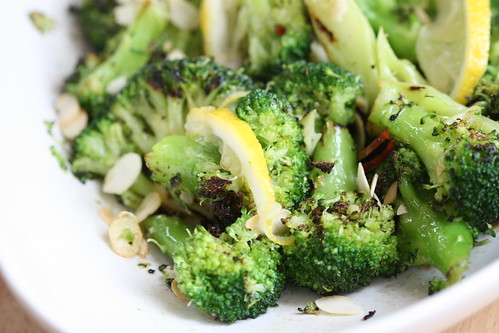
Here's a lovely recipe adapted from London-based Yotam Ottolenghi's first cookbook, Ottolenghi: The Cookbook. The book is full on inspiring vegetarian dishes that I've been drooling over - and cooking - over and over again. I've already blogged about two of the dishes - roasted aubergine/eggplant with saffron yogurt and a refreshing cucumber and poppy seed salad, and here's a lovely vegan side dish using broccoli. I've reduced the amount of oil used in the recipe considerably, but otherwise it's following the book.
Chargrilled broccoli with chilli and garlic
(Röstitud spargelkapsas tšilli ja küüslauguga)
Serves 4
500 g broccoli
4 Tbsp olive oil
4 to 5 garlic cloves, thinly sliced
2 mild red chillies, deseeded and thinly sliced
sea salt flakes and freshly ground black pepper
To garnish:
toasted almond slices or thinly sliced lemon
Separate the broccoli into florets and blanch in boiling water for 2 minutes and not longer! Immediately refresh under cold running water to stop further cooking, then drain and leave to dry completely.
Once the broccoli is dry, toss with 3 Tbsp of the olive oil and season generously with salt and pepper. Place a griddle pan on high heat and leave for 4 to 5 minutes until smoking hot. Grill the broccoli in batches on the hot pan, turning to get lovely charmarks on all sides. When ready, transfer into a heatproof bowl.
While the broccoli is cooking, place the remaining Tbsp of oil in a small saucepan together with sliced garlic and chillies and cook on a medium heat until the garlic begins to turn golden brown. Be careful not to let the garlic and chilli burn – they will continue cooking in the hot oil even when off heat. Pour the garlic and chilli oil over the hot broccoli florets and toss well.
Season to taste, sprinkle with almond slices or lemon slices and serve immediately or at room temperature.

















